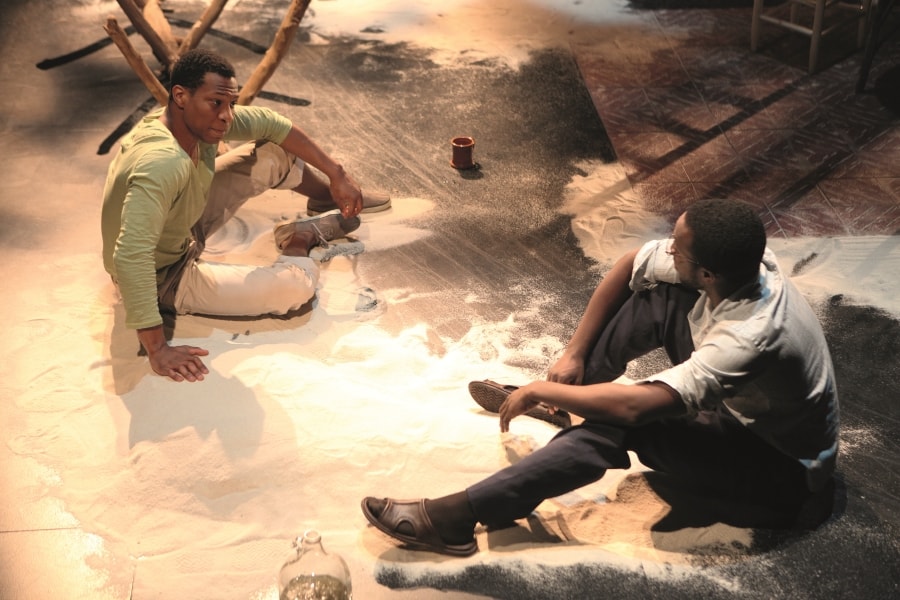If character is destiny, then it makes good sense that director Les Waters has wound up as artistic director of Actors Theatre of Louisville and the Humana Festival of New American Plays. “I think it’s just in my DNA,” observes Waters, the British-born director who arrived in Kentucky last year after a eight-year stint as associate artistic director at California’s Berkeley Repertory Theatre. “Exploring new plays is something I find endlessly fascinating, challenging in all the right ways. It has given me great pleasure—more pleasure than despair,” he adds with a chuckle that straddles weary and waggish tones.
For Waters, new plays are “like guides or maps to contemporary existence.” That proved demonstrably true at this year’s 37th iteration of Humana (this past Feb. 27–April 7), which guided theatregoers into the dusty corners of the human psyche via family, society and the self—not to mention the unconscious. This was true not only of the individually written productions but of the traditional collaborative project as well. For Sleep Rock Thy Brain, conceived by ATL director/dramaturg team Amy Attaway and Sarah Lunnie, three playwrights (Rinne Groff, Lucas Hnath and Anne Washburn) were commissioned to write sleep-inspired (but not inducing) pieces for ATL’s acting apprentice team (in association with the University of Louisville, Lincoln Performing Arts School and ZFX Flying Effects). The results were trippy good fun.
“It’s crucial for institutions to support artists,” says Waters, who is keen on continuing ATL’s tradition of developing devised, ensemble-made work as well as commissioning writers. “It’s who you champion that defines a theatre. When I worked at the Royal Court, our unofficial mantra was, ‘The policy is who you work with.’ For ATL, that will unfold over time.”
In an attempt to champion artists—and feeling inspired by the experiments of Engine31 (see sidebar, page 49)—the editors of American Theatre have taken a new approach in responding to this year’s Humana selections. Short interviews with the playwrights follow, accompanied by an exercise in Engine31’s six-word play summaries. —Bent
JEFF AUGUSTIN: Cry Old Kingdom
6-word summary: Beautiful landscapes don’t make revolutions easier.
What sparked Cry Old Kingdom?
My mom was born a year before “Papa Doc” Duvalier came into power in Haiti, and she left a few years into his son’s reign. Growing up, I read and heard from family members about the atrocities of that time. But my mom would talk mostly about the beauty of the country and her love for it. In an ideal world, I don’t think she ever would’ve left. I became fascinated with why people leave or stay during times of tyranny—and in capturing the beauty of a country that is only ever talked about when there’s a disaster.
What has your mom’s response been to you exploring the history of Haiti in your work?
I think a big concern of hers while raising kids in America has been that we’d lose touch with our culture. So she’s been very supportive and proud—even when I call at 2 a.m. to ask her about popular soccer teams in Haiti in the ’60s!
If the U.S. fell under a repressive regime, what kind of artist would you be?
I’d like to think I’d be a revolutionary. But it’s easy to say that now.
Top three favorite playwrights?
José Rivera, Tennessee Williams, Adrienne Kennedy.
What’s your guilty pleasure, in terms of artistic inspiration?
I spend a lot of hours of my life watching CBS dramas.
What did you discover at Humana in terms of collaborating with your cast and design team?
The play, really. You spend so much time alone writing that it’s hard to see the trappings, or at times even what’s working. Sometimes it isn’t until you’re in a room with a group of talented folk trying to build the play that you truly learn what it is.
What are you currently working on?
I’ll be developing a piece at Berkeley Rep’s Ground Floor this summer, inspired by a form of Haitian storytelling called “Krik? Krak!” It involves three friends reimagining Haitian folktales. I’ll also be working on an eight-person ensemble piece dealing with Haitian mythology and voodoo at the Eugene O’Neill Theater Center this summer.
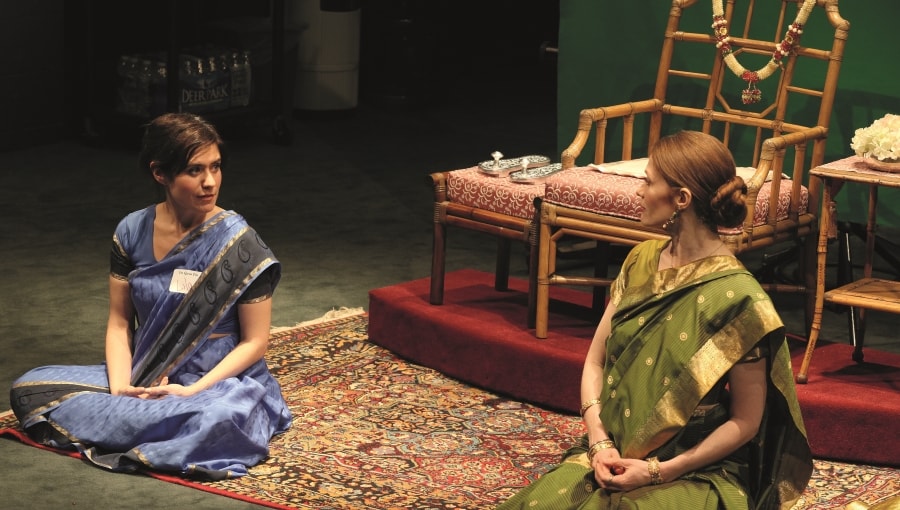
MALLERY AVIDON: O Guru Guru Guru, or why I don’t want to go to yoga class with you
6-word summary: My hamstrings will never loosen. Om.
Did you always know O Guru was going to have a three-part structure?
I was talking with my dramaturg at Brown University about religious iconography and triptychs. The piece started with a version of the Ganesh puppet show, which is like the central religious icon of the triptych. The monologue and the movie set are the side panels that reflect and refract that.
Celebrities crop up in a number of your works—explain!
Pop culture is our common language at this point. My use of Julia Roberts, Dan Savage or Mary-Kate Olsen is to me the same as a reference to Cassandra, Job or Hero.
The play draws on some of your life experiences. How do you know what personal stuff to put in and what to leave out?
It actually is autobiographical (minus the Julia Roberts part). Much of my other work tends to be personal without being strictly autobiographical. My plays end up being hard for me to sit through sometimes. Finding the line between “writing what you know” or “blood on the page” can be hard to balance with sanity.
Also I am always concerned most about making good art, not, like, over-sharing. Sometimes people ask me if the work is therapeutic for me, and I always get weirded out. My hope is that by sharing an artistic representation of some question or truth, the audience can have an experience that moves them through something to a new place. Maybe that’s something like therapeutic…I don’t know. I don’t go to therapy.
Have you ever considered performing in your own work?
There’s this thing I did that’s on YouTube about Mike Daisey. But I only performed it twice. I have terrible stage fright. The idea of a monthlong run is too much for me.
What’s your guilty pleasure in terms of artistic inspiration?
I obsessively listen to music when I’m writing and rehearsing a play. Also, I watch more TV than anyone else I know. I guess that’s how a character from “Grey’s Anatomy” ended up in my play queerSpawn.
Funniest or most surprising audience reaction to your show?
At the first preview, when I looked around and saw that the audience really was mostly over the age of 65, I got kind of freaked out. And then they were totally into it. (That’s about me, though, having preconceived notions.) So many people came up to me after to say: “Your experience and my experience aren’t exactly the same, but my parents were involved in this or that crazy thing.”
One young woman, who went to the same ashram I did when she was a kid, came up after and told me the play made her feel less alone. We’re Facebook friends now.
Any burning questions you never got to ask the other playwrights in this year’s fest?
I want Will Eno to teach me how to be funny.
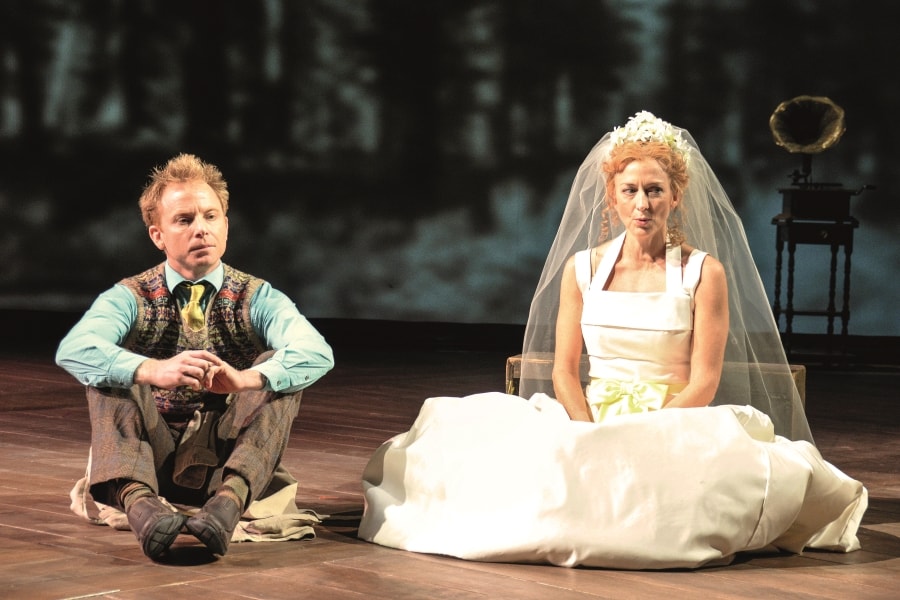
WILL ENO: Gnit
6 word summary: “Hi, I’m a person.” (Heart melt.)
What drew you to adapting Peer Gynt?
One thing that got me started was sympathy for both the character of Solveig, in the original play, and the actress who would play her. Solveig disappears for a couple of acts, about 30 years, and then comes on in the last few minutes to forgive Peer and tell him she’s always loved him. I thought she deserved a little more dimensionality and agency. And, because of that original ending in which there is some sweetness and light, I think the play is a little more misunderstandable than it needs to be—the Solveig stuff raises a larger question about what the play is actually about.
And then I started, along with kind of disliking him, feeling sorry for the character of Peer. Thinking of all this suffering and struggling he has gone through over the last two centuries, it seemed very sad to think that his point was being lost on us, or was outdated in some way. So, though my adaptation probably gets a little aggressive with the original text, it started out of something like love and sympathy. There are some important, hurtful, sort of “classic” things to learn from the play, but I think they can be learned in under two hours and with some laughs along the way.
Tell me about how you conceived of the Danny Wolohan character. Did you know you wanted one person to play those groups?
Danny will be pleased to know that the Town character is now referred to as “the Danny Wolohan character.” Funnily, those are the same words I use to describe Danny himself. In the original, if I remember right, there are these lines that are attributed to a general sort of rabble—among the dramatis personae are these groupings such as wedding guests, funeral party and “several madmen.” So I thought, wouldn’t it be fun and economical to make all those people one character?
Also, in that the play deals so much with issues concerning the self and individuality, I thought it might shed some light on the question (or some darkness on the answer) to have one person playing a whole town—to have one Self able to incorporate and embody all these others, while poor Peter Gnit is tearing himself apart in order to just find himself in one little old self.
Any burning questions you never got to ask the other playwrights in this year’s fest?
I always wonder if other writers have the experience, at some point, of everything suddenly looking like it’s spelled wrong—where you sort of forget how to read for a second. And I always wonder whether that’s a good thing, that moment, or a scary, weird one. And I wonder, if people have that moment, how they feel about it. It’s sort of the written equivalent of the experience of when you’re a kid and you say a word over and over until it sounds alien and not like anything you’ve heard before.
Funniest or most surprising audience reaction to your show?
I don’t know. I probably live in a state of perpetual surprise, to everything, which is an unbearable state, so I sort of tamp it down to myself, and then it all seems like potentially predictable events or outcomes, which is not the case, and I’m wrong to do that, because I’m suddenly really surprised by something, which is an exciting feeling. Charles Schulz, who wrote “Peanuts,” was asked a sort of similar question about his work and he started crying and then said, with some difficulty, something like, “I’m just surprised anyone liked it.”
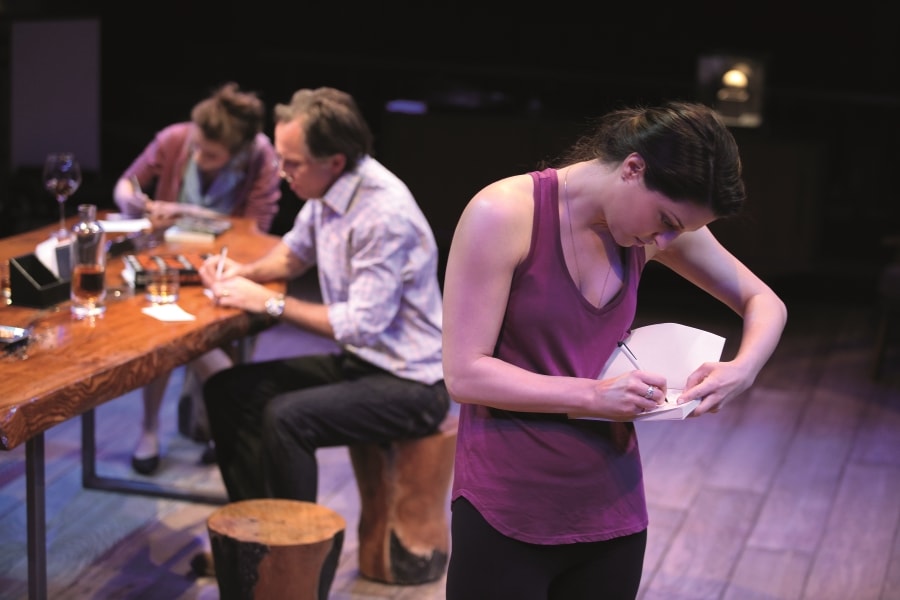
SAM MARKS: The Delling Shore
6-word summary: Authors bloviate, daughters beware. Fancy cheese.
When did you begin writing The Delling Shore?
About two-and-a-half years ago. I had become a father and was thinking about legacy. What’s it like to be the child of great success? Of failure? I was also obsessed with the world of fiction, so I started to write about these hyperliterary people who couldn’t articulate their actual feelings, so they had no choice but to launch terrible barbs at each other. And how two fathers—one doing well, one not—affected their daughters and how their daughters looked at the world through the prism of literary “wordplay.”
Why aren’t there more father/daughter plays?
The father/son legacy/transmission trope is pretty well explored (it’s one of my favorite genres). Daughters, of course, also deal with the legacy of their fathers, but in a surprising way, as there’s both more and less pressure on them to “follow in the footsteps.” Also, bringing in twentysomething daughters adds a very uncomfortable element of sexual tension and the shadow of the offstage mothers.
Jealousy was a palpable theme in your play. How do you manage pangs of envy with your peers?
Feelings of envy are forms of violence against yourself. Focus on your work. If you get to do this, you’re extremely lucky. Paula Vogel says, “The circle rises together.” She’s right.
How does your background in acting affect the way you write?
Other than that I mutter my plays to myself when I’m watching them like a lunatic? I have a tremendous respect for actors. They make or break the production. I respect their instincts about plays.
What did you discover in terms of collaborating with your cast and design team?
How important the space itself becomes—the house is almost a character.
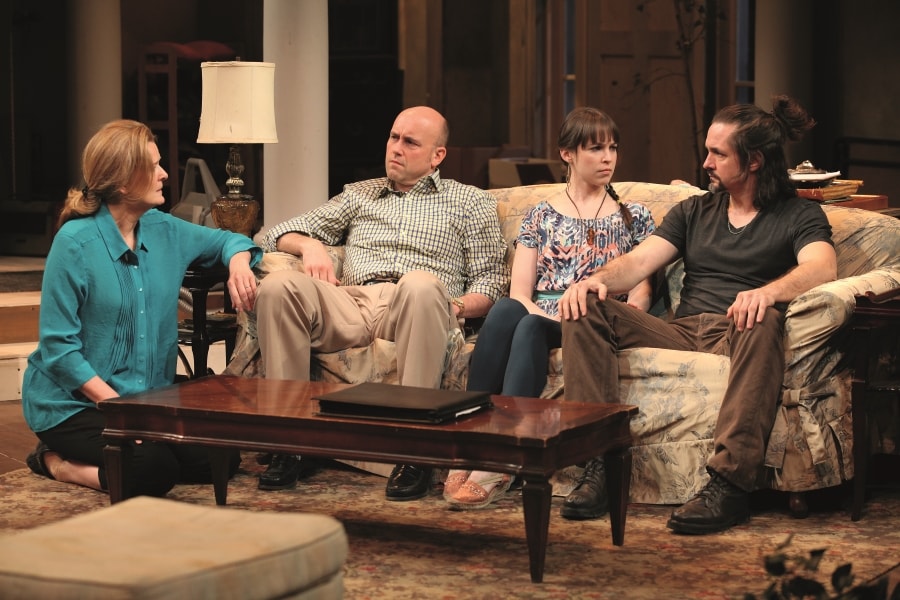
BRANDEN JACOBS-JENKINS: Appropriate
6-word summary: Families are freaky, creepy, inescapable. Eek!
Tell me about the triggers and influences for writing Appropriate.
Triggers is an interesting way of thinking about it. Basically, I encountered four things within a relatively short span of time that one day just sort of coalesced into an idea. The first was a painting by Kerry James Marshall called Heirlooms and Accessories. The second was an essay by Hilton Als called “GWTW.” The third was the success of August: Osage County. The fourth was the news that the house my mother had grown up in, after some years of neglect, had been ransacked by some people in town and, with no one living in it, was literally falling apart.
How does Appropriate fit into your body of work?
I suppose, on some level, it’s a continuation of my general preoccupation with theatrical genre and how history works. Ask me again in 10 years—assuming I’m not dead.
Where do you see Humana in terms of the development of the life of your play?
The play is far from done. The Humana Festival—despite its prestige and production values—is a pretty quick and dirty process, dramaturgically speaking. You get two previews and then everyone wants to fly in and make some sort of verdict and it’s just weird. That being said, I’m very proud of this premiere, and we learned an incredible amount from the Louisville audience, and I’m fortunate to have a couple more opportunities to take a swipe at the storytelling before I have to leave this family alone.
What other plays at this year’s festival surprised or inspired you?
I actually quite liked all of the plays, but I still find myself thinking a lot about Mallery’s play, O Guru Guru Guru.
If you had to cast one of the Humana playwrights in your show, who would you cast and why?
Probably Emily Schwend (whose 10-minute play Halfway premiered this year). Randomly enough, I’ve had the great luck of being in a few games of Mafia with her. She’s a talented liar—which, I think, has something to do with acting?—and a good sparring partner when it comes to shouting matches. The screamier fights in my play could use those kind of lungs.
A burning question you never got to ask another playwright in this year’s fest?
WILL ENO, ARE YOU STILL MAD AT ME ABOUT THAT THING I DID?!?!?!?

